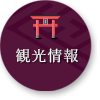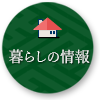English Information SHIWAJOH
広報ID1009525 更新日 令和6年6月11日 印刷
Shiwa-Joh was built in the year 803 by Tamuramaro Sakanoue and the imperial court in Kyoto.
About SHIWAJOH
(from the english guide booklet , published by Omiya Junior High School,2003.)
1 Shiwa-Joh was built about 1200 years ago.
Shiwa-Joh was built in the year 803 by Tamuramaro Sakanoue and the imperial court in Kyoto. It took about 4000 soldiers working continuously, one year to build the great palace, Shiwa-Joh.
Several Johsaku palace were built in northeastern Tohoku district during the Ancient and Classical Japan (Asuka, Nara and early Heian period) (7c-9c). These famous palaces include Taga-Joh (built in about 724), Hotta-no-Saku (built in about 801), Isawa-Joh (built in 802), Tokutan-Joh (built in about 811),and Shiwa-Joh.
The Ancient and Classical Japan, the imperial court in Kyoto, Japan's central government at that time, made a territory expansion policy and tried to advance to this region.However, conflict began between the government and the Emishi people who inhabited the region. Their conflict lasted from 774 to 811, and became known as "the 38 years war".
Shiwa-Joh was established during period as the center of military affairs and administration.
2 Shiwa-Joh was center of military affairs and administration.
Shiwa-Joh was demarcated by a wide outer moat and a tsuijibei wall, which constructed with numerous thin stamped layers of earth. Each side of the tsuijibei wall was 840 meters long, and the moat was 930 meters long. A gate was built in the middle of each side, and turrets were built at 60 meters intervals. The South gate was the most important of all the gates and was a symbol of Shiwa-Joh.
The seicho, the government office area made up the center of Shiwa-Joh. It was 150 meters squared, and it was surrounded by a tsuijibei wall in all sides. The Seiden, the main hall was the center of The Seicho and was the most important building in Shiwa-Joh.
A variety of buildings for administrative work surrounded The Seicho. Pit dwellings lined the inside of the tsuijibei wall to solldiers house. An astonishing 4000 officials and sooldiers lived and worked within Shiwa-Joh.
3 Shiwa-Joh has reopened for modern-day visitors.
Shiwa-Joh was handled military affairs as the administration center of the northern Tohoku District. However, it suffered flood damage and the palace was no longer used. all knowledge of the location of Shiwa-joh was lost, until it finally discovered by researchers in Showa 51(1976).
The restoration of Shiwa-Joh to its former state 1200 years ago began in Heisei 5(1993) and is continuing. Restoration of the south gate and its surrounding area has been completed. The government building that once existed in the center of the palace will be completed in heisei 22(2010).
The restored South Gate is 15 meters wide and 11.1 meters high. The full restoration of the south gate is similar in scope to that of the Suzakumon-Gate of Hijyo-kyu palace in Nara (the capital of Japan in the Nara period (710-794)).
The tsuijibei wall leading to both sides of the gate are made of layers of compressed soil to height of 4.5 meters. Only 252 meters of tsuijibei wall have been restored, but it is the restored wall in Japan.
The turrets made of chestnut and Hiba wood have also been restored. The turrets, which straddle the tsuijibei wall, are 6.95 meters high.
We hope that visitors of restored Shiwa-Joh will be able to get a sence of what this amazing and important place was like in its early days.
Shiwa-Joh was a large-scale palace equal in rank with Taga-Joh (Miyagi prefecture) in the Tohoku District. Shiwa-Joh was a very important palace, containing at its center a government office bigger than that of Taga-Joh.
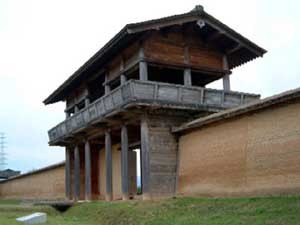
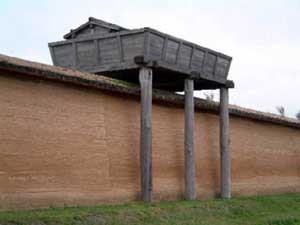
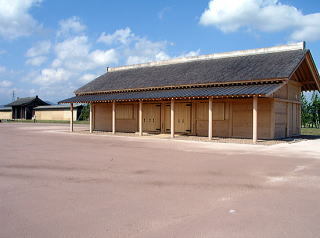
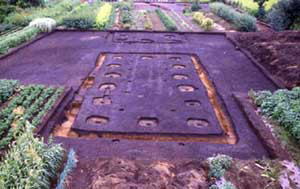
Information
Information Office
Hours 9:00-17:00 (guide until 16 : 30)
Closed
・Every Monday(except national holidays).
・Dec.29 to Jan.3
Admission free
Sorry, there are no guides who speak English well.
Directions
From the east exit of the JR Morioka Station
Take the Motomiya-Haba bus line bound for Iwateken Koutu Yahaba-office.Get off at the Shiwajo Kodaikouen stop.
Shiwajyo Ancient Park is a 0 minute walk from this stop.
From the west exit of the Station
Approximately 15 minutes by taxi.
Location
47-11, Gohei-shinden, Kami-kazuma, Morioka, Iwate. Japan
Phone.fax 019-658-1710
Reference
The Section for Historical and Cultural Affairs, The board of education, Morioka-city office
14-37-2,Tsushida, Morioka, Iwate. Japan
Phone.019-639-9067
E-mail:edu.bunka@city.morioka.iwate.jp
よりよいウェブサイトにするために、このページにどのような問題点があったかをお聞かせください。
このページに関するお問い合わせ
Inquiry
Cultural Affairs Division, Morioka School Board of Education
Tonan Branch Office 3F
14-37-2 Tsushida, Morioka, Iwate 020-8532
電話: 019-639-9067 ファクス:019-639-9047

